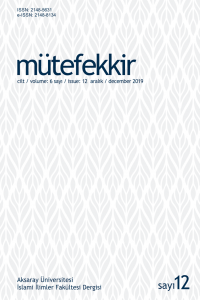Öz
In this paper, syntax and semantic interpretation will be investigated in three books, which are prepared in the same way as the modern linguistics books in terms of the titles mentioned and the topics covered. These books which are written by contemporary authors are İbn Faris’ (d. 395/1004) book al-Sahibi fi fiqh al-lugha, as-Seālibī’s (d. 429/1038) book Fiqhu’l-lugha va sunan al-arabiyya and Ibn Jinni’s (d. 392/1002) book al-Khasāis. In this study, it will be tried to investigate how this is done in the first books of fiqh al-lugha which were written in the fourth century and the first half of the fifth century after the hijra. How do the syntactic changes in Arabic sentences affect semantic interpretation? What are the meaning subtleties in sentences that seemingly have the same meaning but are composed of different sentence structures? These questions constitute the basic problem in our work. At first glance, there are some clues in these books such as repositioning words in the sentence, to use feminine instead of masculine, to use masculine instead of the feminine, to use plural instead of singular, to use singular instead of plural. Moving from these places, the data which can be subject to syntactic and semantic interpretation will be determined in all three books.
Anahtar Kelimeler
Kaynakça
- ʽAlâvene, Şerîf. Şiʽru’s-Seletâni’l-ʽAbdî. Ürdün: y.y., 2007.
- ʽAbîd b. el-Ebras. Dîvân, neşr. Ahmed ʽAdra. Beyrut: Dâru’l-Kitabi’l-ʽArabî, 1994.
- el-Aʽşâ, Meymûn b. Kays. Dîvân, b.y.: y.y., ts.
- İbn Cinnî, Ebu’l-Feth Osman. el-Hasâ’is. Nşr. Abdulhamid Hindâvî. Beyrut: Dâru’l-Kütübi’l-ʽİlmiyye, 2003.
- İbn Fâris. es-Sâhibî fî fıkhi’l-luğa. Nşr. Esseyyid Ahmed Sakr. Mekke: y.y., ts.
- Cerîr. Dîvân. Beyrut: Dâru Beyrut: 1986.
- İmruu’l-Kays. Divân, Nşr. Mustafa Abduşşâfî, Beyrut: Dâru’l-Kütübi’l-ʽİlmiyye, 2004.
- El-Curcânî, Abdulkahir. Delâilu’l-iʽcâz, Nşr. Mahmud Muhammed Şâkir, Kâhire: 1992.
- Ferezdak, Dîvân. Neşr. İlîyâ el-Hâvî. Beyrut: Dâru’l-Kütübi’l-Lubnânî, 1983.
- Hassân b. Sâbit. Dîvân. Nşr. Abde’ Muhennâ. Beyrut: Dâru’l-Kütübi’l-ʽİlmiyye, 1994.
- Hutay’e. Dîvân. Nşr. Hamdû Tammâs. Beyrut: Dâru’l-Maʻrife, 2005.
- Lebîd b. Rebîʻa. Dîvân. Nşr. Hamdû Tammâs, Beyrut: Dâru’l-Maʻrife, 2004.
- Ömer b. Ebî Rebîʽa. Divân. Nşr. Fâyiz Muhammed. Beyrut: Dâru’l-Kütübi’l-ʽArabî, 1996.
- el-Mütenebbî. Dîvân. Beyrut: Dâru Beyrut, 1983.
- es-Seʽâlibî, Ebu Mansûr. Fıkhu’l-luğa ve sirru’lʽArabiyye. Nşr. Hâlid Fehmi vediğ. Kahire: Mektebetü’l-Hâncî, 1998.
- eş-Şemmâh b. Dırâr. Dîvân. Nşr. Ahmed el-Emîn eş-Şenkîtî. Mısır: y.y., 1327h.
- Tarafe b. el-ʽAbd. Dîvân, Nşr. Muhammet Nâsuriddîn. Beyrut: Dâru’l-Kütübi’l-ʽArabî, 2002.
- Zurrumme, Ğaylân b. ʻUkbe el-ʻAdevî. Dîvân. Nşr. ʻAbdulkuddûs Ebû Sâlih. Beyrut: Müessesetü’l-Eymân, 1982.
- Züheyr b. Ebî Sulmâ, Dîvân, Nşr. Ali Hasen Fâʽûr. Beyrut: Dâru’l-Kütübi’l-ʽİlmiyye, 1988.
Öz
Bu makalede, değinilen konular ve ele alınan başlıklar açısından modern dilbilim kitaplarına benzer şekilde hazırlanmış olan üç kitapta, sözdizim ve anlamsal yorum konusu araştırılacaktır. Çağdaş sayılabilecek üç dilcinin yazmış olduğu bu kitaplar: İbn Fâris’in (ö. 395/1004) es-Sâhibî fi fıkhi’l-luğati’l-ʽArabiyye ve aüneni’l-ʽArabi fî kelâmihâ adlı eseri, İbn Cinnî’nin (ö. 392/1002) el-Hasâis ve es-Seâlibî’nin (ö. 429/1038) Fıkhu’l-luğa ve Sırru’l-ʽArabiyye adlı eseridir. Arapça cümlelerdeki sözdizim değişikliği anlamsal yorumu nasıl etkiler? Görünüşte aynı anlama gelen fakat farklı cümle yapılarından oluşan cümlelerdeki anlam incelikleri nelerdir? soruları, çalışmamızın temel problematiğini teşkil etmektedir. İlk bakışta bu kitaplarda, takdim-tehir, müennesin müzekker anlamında; müzekkerin müennes anlamında kullanılması; ceminin müfred, müfredin cemi olarak kullanılması gibi bazı ipuçları göze çarpmaktadır. Buralardan hareketle her üç kitapta da sözdizim ve anlamsal yoruma konu olabilecek veriler tespit edilecektir.
Anahtar Kelimeler
Kaynakça
- ʽAlâvene, Şerîf. Şiʽru’s-Seletâni’l-ʽAbdî. Ürdün: y.y., 2007.
- ʽAbîd b. el-Ebras. Dîvân, neşr. Ahmed ʽAdra. Beyrut: Dâru’l-Kitabi’l-ʽArabî, 1994.
- el-Aʽşâ, Meymûn b. Kays. Dîvân, b.y.: y.y., ts.
- İbn Cinnî, Ebu’l-Feth Osman. el-Hasâ’is. Nşr. Abdulhamid Hindâvî. Beyrut: Dâru’l-Kütübi’l-ʽİlmiyye, 2003.
- İbn Fâris. es-Sâhibî fî fıkhi’l-luğa. Nşr. Esseyyid Ahmed Sakr. Mekke: y.y., ts.
- Cerîr. Dîvân. Beyrut: Dâru Beyrut: 1986.
- İmruu’l-Kays. Divân, Nşr. Mustafa Abduşşâfî, Beyrut: Dâru’l-Kütübi’l-ʽİlmiyye, 2004.
- El-Curcânî, Abdulkahir. Delâilu’l-iʽcâz, Nşr. Mahmud Muhammed Şâkir, Kâhire: 1992.
- Ferezdak, Dîvân. Neşr. İlîyâ el-Hâvî. Beyrut: Dâru’l-Kütübi’l-Lubnânî, 1983.
- Hassân b. Sâbit. Dîvân. Nşr. Abde’ Muhennâ. Beyrut: Dâru’l-Kütübi’l-ʽİlmiyye, 1994.
- Hutay’e. Dîvân. Nşr. Hamdû Tammâs. Beyrut: Dâru’l-Maʻrife, 2005.
- Lebîd b. Rebîʻa. Dîvân. Nşr. Hamdû Tammâs, Beyrut: Dâru’l-Maʻrife, 2004.
- Ömer b. Ebî Rebîʽa. Divân. Nşr. Fâyiz Muhammed. Beyrut: Dâru’l-Kütübi’l-ʽArabî, 1996.
- el-Mütenebbî. Dîvân. Beyrut: Dâru Beyrut, 1983.
- es-Seʽâlibî, Ebu Mansûr. Fıkhu’l-luğa ve sirru’lʽArabiyye. Nşr. Hâlid Fehmi vediğ. Kahire: Mektebetü’l-Hâncî, 1998.
- eş-Şemmâh b. Dırâr. Dîvân. Nşr. Ahmed el-Emîn eş-Şenkîtî. Mısır: y.y., 1327h.
- Tarafe b. el-ʽAbd. Dîvân, Nşr. Muhammet Nâsuriddîn. Beyrut: Dâru’l-Kütübi’l-ʽArabî, 2002.
- Zurrumme, Ğaylân b. ʻUkbe el-ʻAdevî. Dîvân. Nşr. ʻAbdulkuddûs Ebû Sâlih. Beyrut: Müessesetü’l-Eymân, 1982.
- Züheyr b. Ebî Sulmâ, Dîvân, Nşr. Ali Hasen Fâʽûr. Beyrut: Dâru’l-Kütübi’l-ʽİlmiyye, 1988.
Ayrıntılar
| Birincil Dil | Türkçe |
|---|---|
| Konular | Din Araştırmaları |
| Bölüm | Araştırma |
| Yazarlar | |
| Yayımlanma Tarihi | 31 Aralık 2019 |
| Gönderilme Tarihi | 26 Nisan 2019 |
| Yayımlandığı Sayı | Yıl 2019 Cilt: 6 Sayı: 12 |
Aksaray Üniversitesi İslami İlimler Fakültesi dergisi Mütefekkir, her yılın 15 Haziran ve 15 Aralık tarihlerinde olmak üzere basılı ve online olarak yayınlanan, uluslararası akademik ve hakemli bir dergidir.


